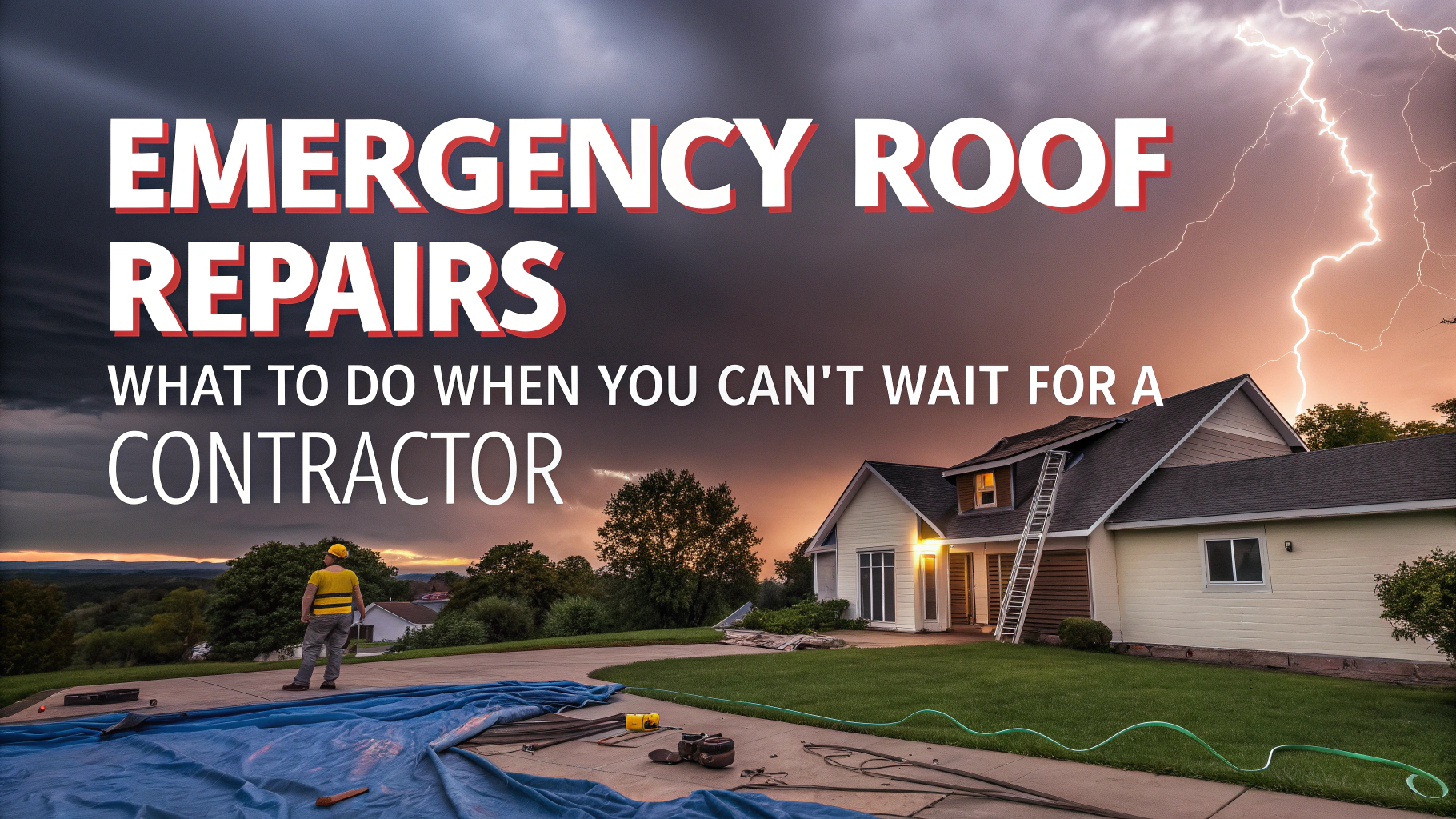A leaking or damaged roof requires immediate action to prevent water damage and structural issues in your home.
Emergency roof repairs can be challenging, especially when professional help isn’t immediately available, but there are several effective temporary solutions you can implement.
This quick guide outlines safe emergency measures for common roof problems while you wait for a qualified Colorado roofing contractor.
Safety First: Before You Start
- Never attempt repairs during storms or high winds
- Ensure your ladder is secured and positioned on level ground
- Wear non-slip shoes and safety equipment
- Work with a partner when possible
- Keep a first-aid kit nearby
Essential Emergency Repair Supplies
- Roofing tarp (minimum 6-mil thickness)
- Roofing nails and screws
- Plywood sheets
- Roof sealant or patch
- Waterproof tape
- Flashlight
Quick Fixes for Common Emergency Situations
For Active Leaks:
- Place buckets under leaks
- Apply roofing tar patch to the affected area
- Install a temporary tarp cover
For Missing Shingles:
- Cover exposed areas with plywood
- Secure with roofing nails
- Apply waterproof tape around edges
Professional Emergency Services in Colorado
Contact these 24/7 emergency roofing services in Colorado:
| Company | Phone | Service Area |
|---|---|---|
| Colorado Emergency Roofing | 800-123-4567 | Denver Metro Area |
| Rocky Mountain Roof Rescue | 877-456-7890 | Colorado Springs |
Documenting Damage for Insurance
- Take clear photos of all damage
- Record the date and time of the incident
- Keep receipts for emergency supplies
- Document weather conditions
Next Steps After Emergency Repairs
Schedule a professional inspection within 24-48 hours of applying temporary fixes.
Request quotes from at least three licensed Colorado roofing contractors.
Contact your insurance company to start the claims process if applicable.
Preventing Future Emergencies
- Schedule bi-annual roof inspections
- Clean gutters regularly
- Trim overhanging branches
- Replace aging shingles proactively
- Keep emergency supplies on hand
When to Call a Professional Immediately
- Structural damage is visible
- Multiple leaks appear simultaneously
- Electrical hazards are present
- Ceiling is sagging or bulging
- Mold growth is visible
Cost Considerations
- Emergency repair supplies: $50-200
- Professional emergency service call: $200-500
- Temporary repairs: $300-1000
- Full roof replacement: $5000-15000+
Working with Insurance
Required Documentation:
- Original installation date of roof
- Maintenance records
- Detailed photos of damage
- Professional assessment report
- Cost estimates for repairs
Weather Considerations in Colorado
- Snow load capacity checks
- Ice dam prevention
- Hail damage assessment
- Wind resistance evaluation
Protecting Your Home and Investment
Remember that emergency repairs are temporary solutions. Establish a relationship with a trusted local contractor before emergencies occur. Keep your roof maintained and inspected regularly to prevent most emergency situations. Store emergency supplies in an easily accessible location, and always prioritize safety over attempting risky repairs.
FAQs
1. What qualifies as a roofing emergency?
Severe water leaks, structural damage from fallen trees, large holes in the roof, extensive shingle damage from storms, or any damage that makes your home unsafe or exposed to the elements.
2. What immediate steps should I take during a roof leak?
Place buckets to catch water, move valuables away from affected areas, tarp any visible exterior holes if safe to do so, and document the damage with photos for insurance purposes.
3. Can I use a tarp as a temporary roof repair solution?
Yes, a properly secured tarp can provide temporary protection for up to 90 days. Ensure it’s at least 6-mil thick and extends from the peak of the roof past the damaged area by at least 4 feet.
4. How do I safely secure a roof tarp in an emergency?
Secure the tarp with 2×4 boards rather than nails alone, wrap the edges around the boards, and secure them to the roof’s eaves. Never attempt this in dangerous weather conditions or if the roof’s stability is compromised.
5. What emergency roofing repairs can I legally do myself in Colorado?
You can perform temporary repairs like tarping, applying roofing tape to small leaks, and removing debris. However, permanent repairs require a licensed contractor per Colorado building codes.
6. Will my homeowner’s insurance cover emergency roof repairs?
Most policies cover emergency repairs from sudden, accidental damage like storms or fallen trees. Document everything and contact your insurance company immediately for guidance on covered repairs.
7. When is it unsafe to attempt DIY emergency repairs?
During lightning storms, high winds (over 20 mph), when there’s structural damage, if the roof pitch is steep (over 4:12), or if you notice sagging or hear cracking sounds from the roof structure.
8. What should be in an emergency roof repair kit?
Heavy-duty tarps, roofing tape, rubber sheets, silicone or roofing sealant, plywood sheets, 2×4 boards, rope, hammer, nails, utility knife, and safety equipment (gloves, goggles, non-slip shoes).
9. How can I find an emergency roofing contractor in Colorado?
Look for contractors licensed in Colorado who offer 24/7 emergency services, check their credentials on the Colorado Department of Regulatory Agencies website, and verify they have local physical business addresses.
10. What are signs that a roof leak requires immediate emergency attention?
Multiple leak points, water pooling in ceiling bulges, sagging ceilings, wet electrical fixtures, water-soaked insulation, or visible sunlight through the roof deck.
11. How long can I wait before addressing a roof leak?
Never wait – even small leaks should be addressed immediately as they can lead to structural damage, mold growth, and electrical hazards within 24-48 hours of water infiltration.
